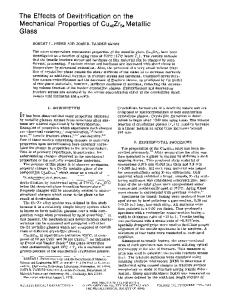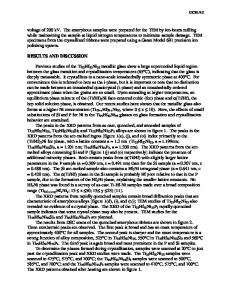Influence of casting temperature on microstructures and mechanical properties of Cu 50 Zr 45.5 Ti 2.5 Y 2 metallic glass
- PDF / 1,227,251 Bytes
- 8 Pages / 584.957 x 782.986 pts Page_size
- 52 Downloads / 309 Views
Haifeng Zhanga) Shenyang National Laboratory for Materials Science, Institute of Metal Research, Chinese Academy of Sciences, Shenyang 110016, China
Hao Wang Faculty of Engineering and Surveying, The University of Southern Queensland, Toowoomba, Queensland 4350, Australia
Bingzhe Ding and Zhuang-Qi Hu Shenyang National Laboratory for Materials Science, Institute of Metal Research, Chinese Academy of Sciences, Shenyang 110016, China
Han Huang Division of Mechanical Engineering, School of Engineering, The University of Queensland, Brisbane, Queensland 4072, Australia (Received 17 March 2009; accepted 6 May 2009)
The influence of casting temperatures on microstructures and mechanical properties of rapidly solidified Cu50Zr45.5Ti2.5Y2 alloy was investigated. With increasing casting temperatures, the amount of the crystalline phase decreases. At a high casting temperature, i.e., 1723 K, glass-forming ability (GFA) of the present alloy is enhanced. The results imply that adjusting the casting temperature could be used for designing the microstructures of bulk metallic glass matrix composite. Nanoindentation tests indicated that CuZr phases are slightly softer and can accommodate more plastic deformation than the amorphous matrix. Compression tests confirmed that this kind of second phase (CuZr) precipitated under lower casting temperatures helps to initiate multiple shear bands, resulting in a great improvement in mechanical properties of the samples. Our work indicates that casting temperatures have a great influence on GFA, microstructures, and mechanical properties of the rapidly solidified alloy, therefore controlling the casting temperature is crucial to the production of BMGs.
I. INTRODUCTION
Properties of materials depend on their microstructures, while the microstructures are closely correlated to the manufacturing process used. Many processing methods, for example, quenching, annealing, cold working, etc., are developed to achieve the desired microstructures, further leading to obtaining the optimal properties.1 Melt treatment, including ultrasonic vibration treatment,2 superhigh temperature treatment,3–5 etc., is evidenced to be effective in changing the microstructures and improving the properties of Al-, Ni-, and Fea)
Address all correspondence to this author. e-mail: [email protected] DOI: 10.1557/JMR.2009.0373
3108
http://journals.cambridge.org
J. Mater. Res., Vol. 24, No. 10, Oct 2009 Downloaded: 14 Mar 2015
based alloys and have been widely used in industrial production. Metallic glass (MG) has been developed for almost 50 years.6 Similar to the steel industry, the database among processes, microstructures, and properties for bulk metallic glasses (BMGs) should be built up to promote their commercial applications.7 In the past few decades, the researchers in this field have concentrated on developing alloy compositions with large glass-forming ability (GFA), in all common alloy systems, and understanding the relationship between microstructures and properties.8–10 Some significant progress has
Data Loading...











